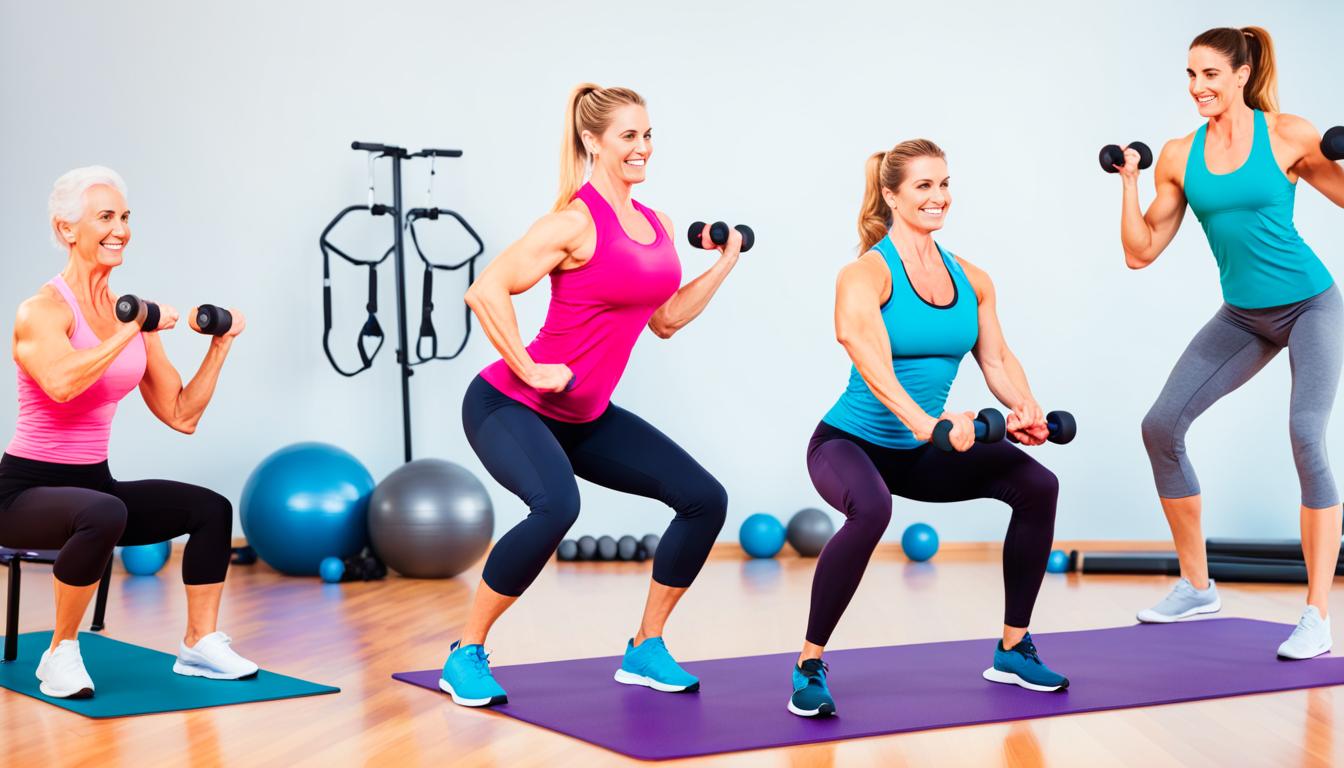Are you or a loved one living with osteoporosis? The fear of fractures and limited mobility can be daunting. But what if there was a way to improve bone density and reduce the risk of fractures? The answer lies in weight-bearing exercises specifically designed for individuals with osteoporosis.
In this section, we will explore the top 5 weight-bearing exercises that are safe and effective for individuals with osteoporosis. These exercises have been carefully selected to promote bone strength and enhance overall mobility. Get ready to take control of your bone health and embrace a more active lifestyle!
Key Takeaways:
- Weight-bearing exercises can help improve bone density and reduce the risk of fractures in individuals with osteoporosis.
- The top 5 weight-bearing exercises for osteoporosis are specifically designed to strengthen bones and enhance mobility.
- By incorporating these exercises into your routine, you can take control of your bone health and enjoy a more active lifestyle.
- Consulting with healthcare providers and understanding your current bone health and fitness levels is crucial before starting a new exercise program.
- Monitoring progress and adapting your osteoporosis workouts over time are essential for continued improvement.
Understanding Osteoporosis and Exercise Benefits
Osteoporosis is a condition characterized by weak and brittle bones, making individuals vulnerable to fractures. Regular exercise plays a crucial role in strengthening bones and reducing the risk of fractures. It is important to choose exercises that are safe and effective for bone health. In this section, we will delve into the benefits of exercise for individuals with osteoporosis and provide guidelines for choosing suitable exercises.
How Exercise Strengthens Bones and Reduces Fracture Risks
Exercise is vital for individuals with osteoporosis as it helps strengthen bones and reduce the risk of fractures. When we engage in weight-bearing and resistance exercises, our bones experience controlled stress, which stimulates the production of new bone tissue. This process, known as bone remodeling, fosters increased bone density and strength. Additionally, exercise improves balance, coordination, and muscle strength, which are essential for preventing falls and fractures.
Osteoporosis patients who consistently engage in exercise experience improved bone health outcomes. Research shows that exercise can not only slow down bone loss but also reverse it and even increase bone mineral density. These benefits are particularly significant in postmenopausal women, who are at a higher risk of developing osteoporosis due to hormonal changes.
Choosing Safe and Effective Exercises for Bone Health
Not all exercises are suitable for individuals with osteoporosis. It is crucial to choose exercises that are safe and effective for bone health. Here are some key considerations:
- Focus on weight-bearing exercises: Weight-bearing exercises involve activities that put stress on your bones and stimulate bone growth. These can include walking, jogging, dancing, and stair climbing.
- Incorporate resistance training: Resistance exercises, such as lifting weights or using resistance bands, help promote muscle strength, which indirectly supports bone health.
- Avoid high-impact activities: Exercises that involve repetitive jumping or running may increase the risk of fractures. It is important to opt for low-impact alternatives, such as swimming or cycling.
- Consult with a healthcare professional: Before starting any exercise program, it is advisable to consult with a healthcare professional who can provide personalized recommendations based on your specific needs and medical history.
By choosing safe and effective exercises, individuals with osteoporosis can harness the benefits of exercise while minimizing the risk of injury. Regular exercise, combined with a balanced diet rich in calcium and vitamin D, can significantly improve bone health and reduce the impact of osteoporosis.
The Role of Weight Bearing Activities in Bone Density Maintenance
Weight-bearing activities play a crucial role in maintaining bone density and preventing the progression of osteoporosis. These activities involve any form of exercise where you are on your feet and supporting your body weight. By engaging in weight-bearing exercises, you can slow down bone loss and promote the strengthening of bones.
Weight bearing activities stimulate the bones to adapt and become stronger, which helps to maintain bone density. These exercises involve the use of body weight or external weights to create resistance and stress on the bones. This stress then signals the bone to restructure and build more bone tissue, leading to increased bone density over time.
The physiological mechanisms behind bone strengthening through exercise are multifaceted. When you engage in weight-bearing activities, the muscular contractions produced by your muscles pull on the bone, stimulating bone cells called osteoblasts to lay down new bone tissue. This remodeling process helps to increase bone density and strengthen the overall skeletal structure.
Additionally, weight-bearing activities also enhance muscle strength and coordination, which further support the health of your bones. Strengthening the muscles surrounding the bones improves stability and reduces the risk of falls and fractures, especially in individuals with osteoporosis.
Incorporating weight-bearing activities into your routine is essential for maintaining bone density and promoting overall bone health. These exercises can include activities such as walking, jogging, dancing, hiking, stair climbing, and weightlifting. The key is to choose activities that are safe and enjoyable for you, so you can consistently engage in them.
Regular participation in weight-bearing activities, combined with a well-balanced diet rich in calcium and vitamin D, can significantly improve bone density and reduce the risk of osteoporosis-related fractures. Consult with your healthcare provider or a qualified exercise professional to determine the best weight-bearing activities for your specific needs and fitness level.
Navigating Weight Bearing Exercises for Osteoporosis Safely
When it comes to weight bearing exercises for osteoporosis, safety should be a top priority. By following the right guidelines and consulting with healthcare providers, individuals can ensure they are engaging in a safe exercise program that promotes bone health and minimizes the risk of injury.
Consulting Healthcare Providers Before Starting a New Exercise Program
Before beginning any new exercise program, it is crucial to consult with healthcare providers who specialize in osteoporosis. These professionals can assess your current bone health and fitness levels to determine the appropriate exercises for your needs. They may also provide additional recommendations or modifications to ensure your safety and maximize the benefits of the exercise program.
Remember: Your healthcare provider is your partner in maintaining bone health and preventing injuries. Always seek their guidance and expertise before starting or making changes to your exercise routine.
Understanding Your Current Bone Health and Fitness Levels
Understanding your current bone health and fitness levels is essential for selecting appropriate weight bearing exercises. Healthcare providers can perform bone density tests to assess your bone health and provide insights into the best exercise options. Additionally, they can evaluate your overall fitness levels, taking into account factors such as strength, balance, and flexibility. This information will help tailor a safe and effective exercise program for you.
By consulting with healthcare providers and understanding your bone health and fitness levels, you can navigate weight bearing exercises for osteoporosis safely and confidently. Remember, a personalized exercise program that aligns with your specific needs and abilities is key to promoting bone health and overall well-being.
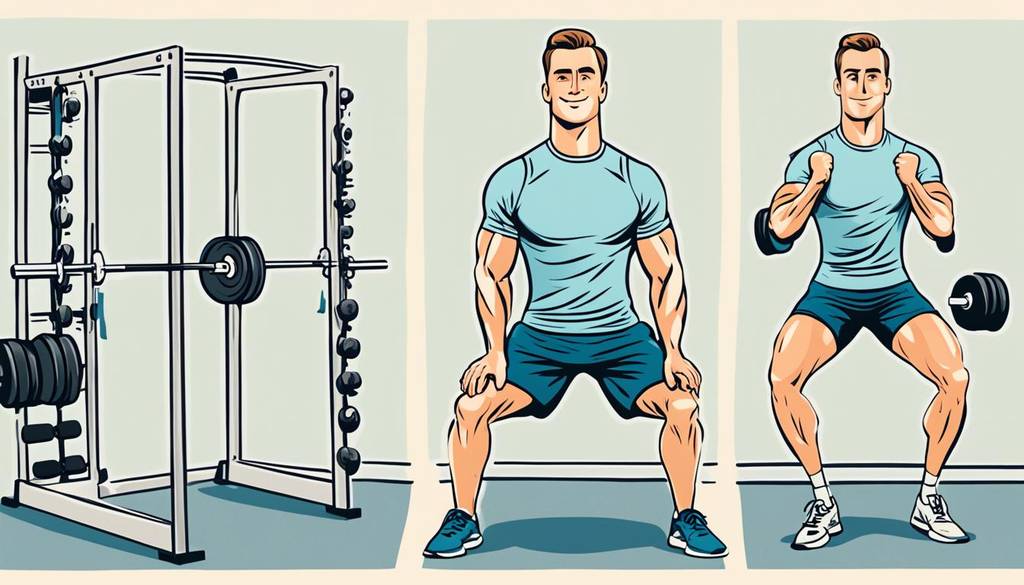
5 Best Weight Bearing Exercises for Osteoporosis
Incorporating weight-bearing exercises into your routine is crucial for individuals with osteoporosis. These exercises can help increase bone density and strengthen weak bones, reducing the risk of fractures. Here are the top 5 best weight-bearing exercises recommended for individuals with osteoporosis:
- Walking: Walking is a low-impact exercise that provides weight-bearing benefits for the bones. Aim for at least 30 minutes of brisk walking every day to increase bone density.
- Dancing: Dancing is not only a fun and enjoyable activity but also an excellent weight-bearing exercise. Join a dance class or dance at home to enhance bone strength and flexibility.
- Stair Climbing: Climbing stairs is an effective weight-bearing exercise that targets the lower body. If you don’t have stairs at home, consider using a stair climber machine at the gym.
- Hiking: Hiking on uneven terrain provides a natural weight-bearing challenge for the bones. Find scenic trails in your area and enjoy the benefits of both exercise and fresh air.
- Weightlifting: Incorporating weightlifting exercises into your routine can help increase bone density. Start with light weights and gradually increase the resistance as your strength improves.
To perform these exercises correctly, it is essential to maintain proper form and listen to your body. Consulting with a healthcare provider or a qualified fitness professional can provide personalized guidance and ensure that you perform these exercises safely and effectively.
Remember to start slowly and gradually increase the intensity and duration of your workouts over time. Consistency is key to achieving optimal results and improving your bone health.

Incorporating Strength Training for Osteoporosis Into Your Routine
Strength training exercises are an essential component of an osteoporosis workout routine. They not only promote muscle strength but also play a crucial role in enhancing bone health. By engaging in strength training exercises, individuals with osteoporosis can effectively increase bone density and reduce the risk of fractures.
Beneficial Strength Training Exercises for Bone Health
When it comes to strength training for osteoporosis, it is important to focus on exercises that target the major muscle groups and put stress on the bones, stimulating them to grow stronger. Here are some beneficial strength training exercises to consider:
- Squats: Squats are an excellent exercise for strengthening the muscles in your lower body, including your quadriceps and glutes. They also promote bone density in areas like the hips and knees.
- Lunges: Lunges help strengthen the muscles in your legs while also putting stress on the bones in your hips and knees. They can be modified to suit different fitness levels.
- Push-ups: Push-ups target your chest, shoulders, and triceps. They also engage the muscles in your back, promoting good posture and supporting spinal health.
- Plank: Planks engage your core muscles, which are essential for maintaining balance and stability. They also help support the spine and improve posture.
- Deadlifts: Deadlifts are a compound exercise that targets multiple muscle groups, including the back, hips, and legs. They are an effective way to promote overall strength and bone health.
It is important to start with light weights or resistance bands and gradually increase the intensity as your strength improves. Remember to maintain proper form throughout each exercise to minimize the risk of injury.
Using Free Weights and Resistance Bands Safely
When incorporating strength training exercises into your osteoporosis routine, it is essential to prioritize safety. Here are some guidelines for using free weights and resistance bands safely:
- Start with light weights or resistance: Begin with weights or bands that are comfortable for you to handle. Focus on mastering the exercise technique before gradually increasing the resistance.
- Ensure proper form: Use proper form and technique during each exercise to prevent unnecessary strain on your joints and spine. If needed, consult a fitness professional to ensure you are performing the exercises correctly.
- Listen to your body: Pay attention to any discomfort or pain during the exercises. If something doesn’t feel right, modify the exercise or seek guidance from a healthcare professional.
- Warm-up and cool-down: Always warm up your muscles with gentle movements or light cardiovascular exercise before starting your strength training routine. Likewise, cool down with stretches to promote flexibility and prevent muscle soreness.
- Be consistent: Consistency is key when it comes to strength training for osteoporosis. Aim for at least two to three sessions per week, allowing your muscles and bones adequate time to recover and adapt.
Incorporating strength training exercises, using free weights or resistance bands, into your routine can have a significant positive impact on your bone health. Remember to consult with a healthcare professional before starting any new exercise program, especially if you have any underlying health conditions or concerns.
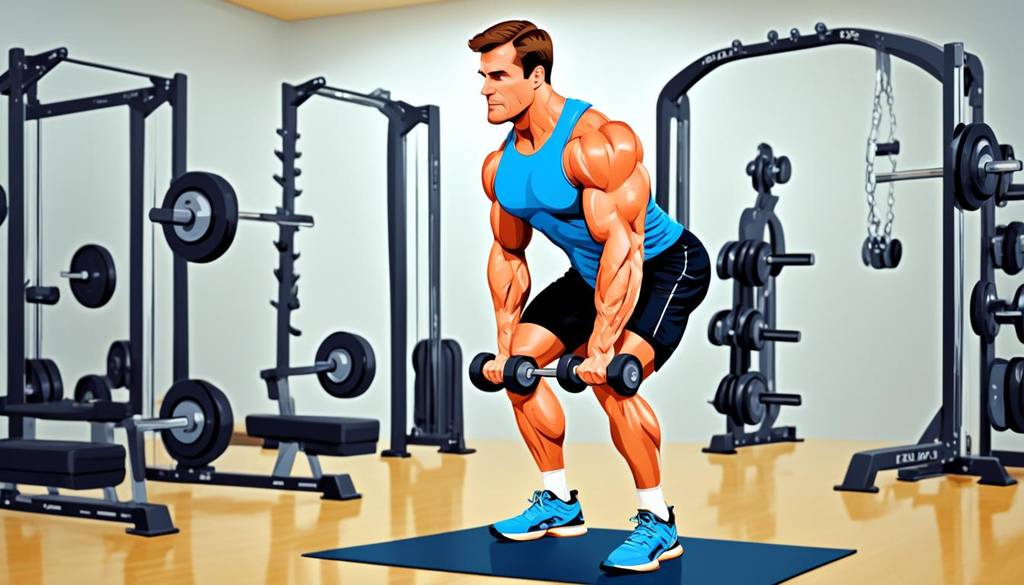
Building Balance and Coordination with Osteoporosis Exercises
Building balance and coordination is crucial for individuals with osteoporosis, as it helps lower the risk of falls and fractures. In addition to weight-bearing exercises, incorporating balance exercises into an osteoporosis exercise routine can further enhance stability and reduce the risk of accidents.
Balance Exercises That Lower the Risk of Falls
Balance exercises focus on improving postural stability and control, making them essential for individuals with osteoporosis. These exercises help strengthen the muscles that support balance and improve coordination. Here are some balance exercises that can be incorporated into your routine:
- Single-leg stands: Stand on one leg for 30 seconds, gradually increasing the duration as you build strength and stability.
- Heel-to-toe walk: Take small steps, placing the heel of one foot directly in front of the toes of the other foot. This exercise challenges balance and coordination.
- Leg swings: Stand next to a wall or sturdy object for support. Swing one leg forward and backward while maintaining balance. Repeat with the other leg.
These exercises can be performed daily or as recommended by your healthcare provider. Start with caution and gradually increase the intensity as your balance improves.
Benefits of Tai Chi and Yoga for Improving Stability
Tai Chi and Yoga are holistic exercises that prioritize body awareness, stability, and mindfulness. They are well-suited for individuals with osteoporosis as they combine gentle movement with deep breathing and mental focus. These practices offer several benefits for improving stability:
Tai Chi: Tai Chi is a traditional Chinese martial art that emphasizes slow, controlled movements. The flowing nature of Tai Chi helps promote balance, flexibility, and coordination. Research has shown that regular Tai Chi practice can significantly reduce the risk of falls and improve quality of life for individuals with osteoporosis.
Yoga: Yoga combines physical postures, breathing techniques, and meditation. Certain yoga poses can enhance stability by challenging your balance and activating the core muscles. Gentle yoga classes or modified poses that take into account any restrictions or limitations can be beneficial for individuals with osteoporosis.
Consult with a qualified instructor or healthcare professional to ensure that you practice Tai Chi or Yoga safely and effectively. They can guide you in selecting appropriate modifications or variations based on your individual needs.
By incorporating balance exercises and practices like Tai Chi and Yoga into your osteoporosis exercise routine, you can significantly improve your stability, reduce the risk of falls, and enhance overall well-being.
Effective Low-Impact Aerobics for Bone Density Enhancement
Engaging in low-impact aerobic exercises is an effective way to enhance bone density for individuals with osteoporosis. These aerobic activities provide the benefits of cardiovascular exercise without imposing excessive stress on the joints, making them ideal for those with fragile bones.
Walking and Dancing as Osteoporosis-Friendly Aerobic Activities
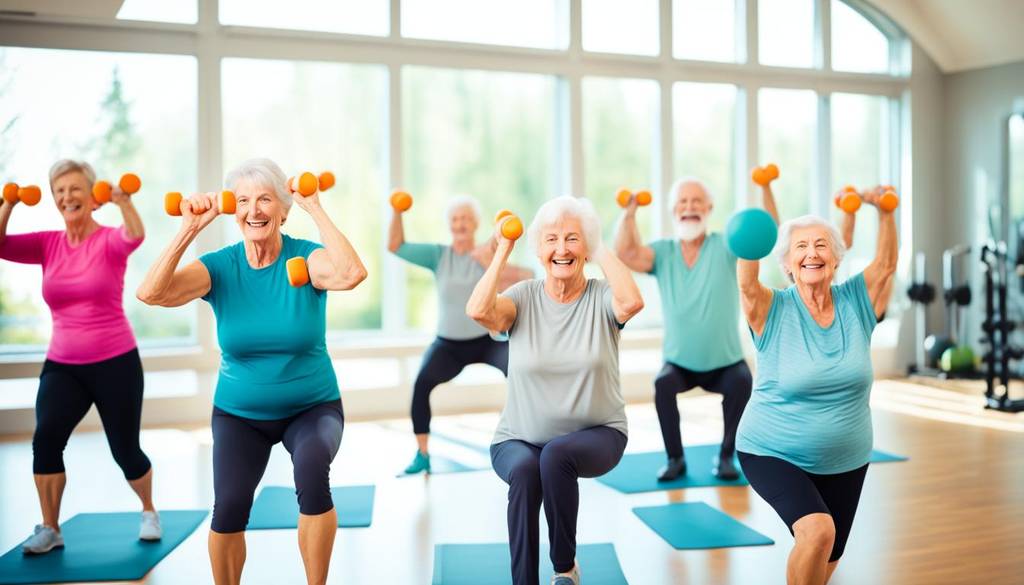
Walking: Walking is a simple and accessible aerobic exercise that can be easily incorporated into daily life. It is a weight-bearing activity that stimulates bone growth in the legs and hips, enhancing bone density. Aim for a brisk pace to maximize the benefits.
Dancing: Dancing is a fun and engaging aerobic activity that provides numerous benefits for individuals with osteoporosis. It combines movement, coordination, and weight-bearing exercise, promoting bone density enhancement and balance improvement. Choose dance styles that are low-impact, such as ballroom dancing or Zumba, to minimize the risk of falls and fractures.
Choosing the Right Intensity Level for Aerobic Exercises
When engaging in aerobic exercises, it is essential to choose the appropriate intensity level to optimize bone density enhancement and overall fitness. Consider the following guidelines:
- Start slowly: If you are new to aerobic exercise or have been inactive for a while, begin with low-intensity activities such as leisurely walks or gentle dancing.
- Gradually increase intensity: As your fitness level improves, gradually increase the duration and intensity of your aerobic workouts. This can include brisk walking or more vigorous dance routines.
- Listen to your body: Pay attention to how your body feels during and after exercise. If you experience pain or discomfort, reduce the intensity or choose alternate activities.
- Consult with a healthcare professional: If you have any underlying health conditions or concerns, consult with your healthcare provider to determine the most suitable intensity level for your aerobic exercises.
Incorporating low-impact aerobics such as walking and dancing into your osteoporosis exercise routine can help enhance bone density, improve cardiovascular health, and boost overall well-being. Remember to choose the right intensity level and consult with a healthcare professional to ensure a safe and effective exercise program.
Emphasizing Flexibility and Posture in an Osteoporosis Workout
Flexibility and posture are key factors in maintaining overall skeletal health for individuals with osteoporosis. Incorporating stretching exercises and postural training into an osteoporosis workout can help improve flexibility, enhance posture, and support bone health.
Stretching Exercises That Benefit Osteoporosis Patients
Stretching exercises are an essential component of an osteoporosis workout as they can help increase range of motion, improve flexibility, and reduce muscle tension. These exercises target specific muscle groups and can be performed both before and after other forms of exercise. They not only promote skeletal health but also contribute to better overall physical well-being.
“Regular stretching exercises can help improve flexibility, maintain joint mobility, and prevent muscle imbalances that may contribute to poor posture.”
Here are a few stretching exercises that are particularly beneficial for individuals with osteoporosis:
- Neck Stretch: Gently tilt your head to one side, bringing your ear closer to your shoulder. Hold for 15-30 seconds and repeat on the other side.
- Shoulder Stretch: Interlace your fingers behind your back and gently lift your arms upward while squeezing your shoulder blades together. Hold for 15-30 seconds.
- Hamstring Stretch: Sit on the edge of a chair and extend one leg forward. Keeping your back straight, gently lean forward until you feel a stretch in the back of your thigh. Hold for 15-30 seconds and repeat with the other leg.
- Calf Stretch: Stand facing a wall and place your hands on the wall for support. Step one foot back, keeping it straight, and press your heel into the ground. You should feel a stretch in your calf muscle. Hold for 15-30 seconds and switch legs.
Postural Training to Support Skeletal Health
Good posture is essential for individuals with osteoporosis as it helps reduce the risk of falls and spinal compression fractures. Postural training exercises focus on improving alignment, core stability, and balance. These exercises promote proper spinal alignment, strengthen the muscles that support the spine, and enhance overall posture.
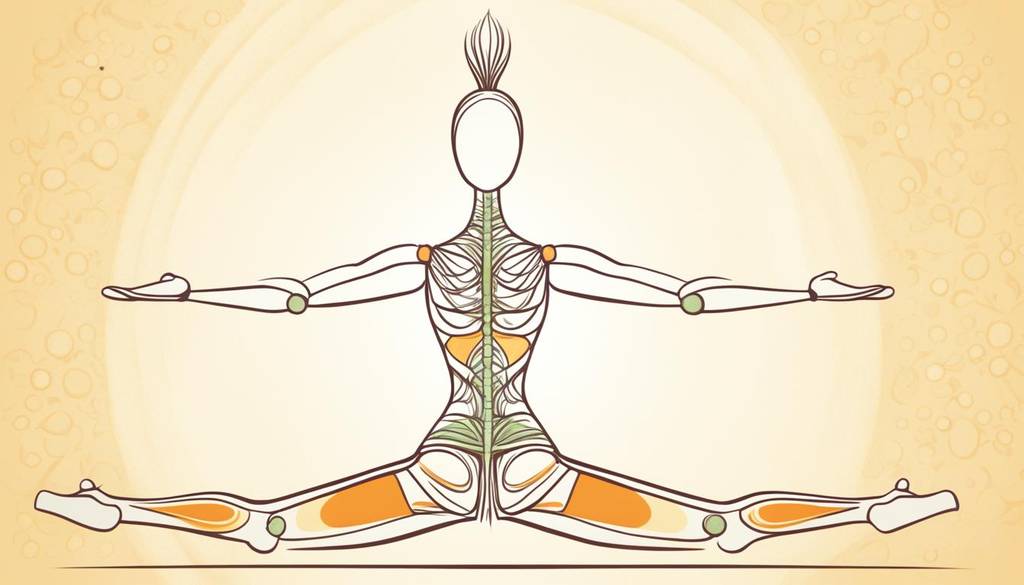
Sample exercises for postural training include:
- Plank: Start in a push-up position, but instead of resting on your hands, lower onto your forearms. Ensure that your body is in a straight line from head to toe. Hold the position for 30 seconds to 1 minute.
- Bridge: Lie on your back with your knees bent and your feet flat on the floor. Lift your hips off the ground, keeping your shoulder blades and feet firmly planted. Hold for 10-30 seconds.
- Superman Pose: Lie face down with your arms extended in front of you and your legs straight. Lift your arms, chest, and legs off the ground simultaneously, squeezing your shoulder blades together. Hold for 10-30 seconds.
By incorporating these stretching exercises and postural training techniques into an osteoporosis workout routine, individuals can improve flexibility, enhance posture, and support their skeletal health.
Practical Tips for Incorporating Osteoporosis Exercises Into Daily Life
Incorporating osteoporosis exercises into your daily life is crucial for long-term bone health. Making exercise a habit and incorporating home-based exercises can effectively increase bone density. Here are some practical tips to help you integrate osteoporosis exercises into your daily routine:
Making Exercise a Habit for Long-Term Bone Health
Establishing a daily exercise routine is key to ensuring the long-term health of your bones. Here are some tips to help you make exercise a habit:
- Set achievable goals: Start with small goals and gradually increase the intensity and duration of your workouts.
- Find activities you enjoy: Choose exercises that you enjoy doing to make it easier to stick to your routine.
- Make it a priority: Schedule your exercise sessions in advance and treat them as non-negotiable commitments.
- Get an exercise buddy: Find a friend or family member who can join you in your workouts to help keep you motivated.
- Reward yourself: Treat yourself to small rewards for consistently sticking to your exercise routine.
Ideas for Home-Based Exercises to Increase Bone Density
Exercising at home is convenient and can be just as effective as going to a gym. Here are some home-based exercises that can help you increase bone density:
1. Weight-bearing exercises: Activities that involve bearing your weight, such as walking, jogging, or climbing stairs, can help strengthen bones. Include at least 30 minutes of weight-bearing exercises in your daily routine.
2. Resistance training: Using resistance bands or free weights can help build muscle strength and increase bone density. Perform exercises like bicep curls, squats, and lunges to target major muscle groups.
3. Yoga or Pilates: These low-impact exercises focus on flexibility, balance, and core strength. They can improve posture and help prevent falls and fractures.
4. Tai Chi: This gentle martial art combines graceful movements and deep breathing, promoting balance, flexibility, and relaxation. It is beneficial for both physical and mental well-being.
5. Stretching: Regular stretching exercises can improve flexibility and range of motion, reducing the risk of falls and fractures.
Remember to consult with your healthcare provider before starting any new exercise program, especially if you have existing health conditions or concerns related to your bone health.
Understanding Exercises to Avoid with Osteoporosis
When it comes to managing osteoporosis, it is important to be aware of certain exercises that should be avoided. These exercises can put individuals with weak bones at a higher risk of fractures and injuries. By understanding these high-risk movements and activities, individuals can take proactive steps to prevent potential harm.
Identifying High-risk Movements and Activities
High-impact exercises that involve jumping, bouncing, or sudden jarring movements should be avoided by individuals with osteoporosis. These movements can put excessive stress on weak bones and increase the likelihood of fractures. Examples of exercises to avoid include:
- High-impact aerobics: Activities such as running, jumping jacks, and intense dance cardio workouts can be too jarring for weak bones.
- High-intensity interval training (HIIT): HIIT exercises that involve rapid bursts of intense activity followed by short rest periods can be too demanding on the skeletal system.
- Heavy weightlifting: Lifting heavy weights without proper form and guidance can lead to injuries, especially for individuals with osteoporosis.
- Contact sports: Activities like football, basketball, and martial arts can pose a high risk of falls and collisions, which can result in fractures.
By avoiding these high-risk movements and activities, individuals with osteoporosis can significantly reduce the chances of injury and ensure their safety during exercise.
Adapting Exercises to Minimize Stress on Weak Bones
While there are exercises to avoid, it is important to note that individuals with osteoporosis can still enjoy a variety of safe and beneficial activities. By adapting exercises to minimize stress on weak bones, individuals can continue to stay active and maintain their overall fitness. Some tips for adapting exercises include:
- Choose low-impact alternatives: Opt for exercises that are gentler on the joints and bones, such as swimming, cycling, or using an elliptical machine.
- Modify high-impact exercises: If you enjoy activities like dancing or aerobics, consider modifying them to lower impact versions. For example, try low-impact dance workouts or step aerobics without jumping.
- Use proper form and technique: Ensure that you are using correct form and technique while performing exercises to minimize the risk of injury. Seek guidance from a certified fitness professional if needed.
- Listen to your body: Pay attention to any discomfort or pain during exercises and modify or stop the activity if necessary. It is essential to prioritize your safety and well-being.
By adapting exercises and being mindful of your body’s needs, individuals with osteoporosis can continue to engage in physical activity while minimizing the stress on their weak bones.
Monitoring Progress and Adapting Osteoporosis Workouts Over Time
Ensuring continued improvement in managing osteoporosis requires a diligent approach to monitoring progress and adapting workouts over time. While exercise plays a crucial role in improving bone density, it is essential to set realistic expectations for the rate of improvement.
When embarking on an osteoporosis workout routine, it is important to understand that bone density improvement can vary from person to person. Factors such as age, overall health, and the severity of osteoporosis can influence the rate of improvement. It is advisable to consult with a healthcare provider to establish realistic goals that align with individual circumstances.
Setting Realistic Expectations for Bone Density Improvement
Setting realistic expectations is essential to prevent frustration and ensure long-term commitment. While regular exercise has been proven to enhance bone density, it is a gradual process that requires consistency and dedication. Understanding that noticeable improvements may take time will help individuals stay motivated and committed to their osteoporosis workout.
Assessing the Impact of Exercise on Osteoporosis Through Regular Check-Ups
To accurately track the progress of the osteoporosis workout routine and its impact on bone density, regular check-ups with a healthcare provider are crucial. These check-ups may involve bone density scans or other assessments to measure changes and identify areas for improvement. Healthcare providers can also provide personalized advice on adapting workouts based on progress and any specific concerns or limitations.
By monitoring progress and adapting workouts over time, individuals can optimize the benefits of exercise for managing osteoporosis. With realistic expectations, regular check-ups, and a commitment to consistency, individuals can work toward improving bone density and overall bone health.
Source Links
- https://www.webmd.com/osteoporosis/features/exercise-weight-bearing
- https://www.mayoclinic.org/diseases-conditions/osteoporosis/in-depth/osteoporosis/art-20044989
- https://www.goodrx.com/conditions/osteoporosis/exercises-for-osteoporosis

